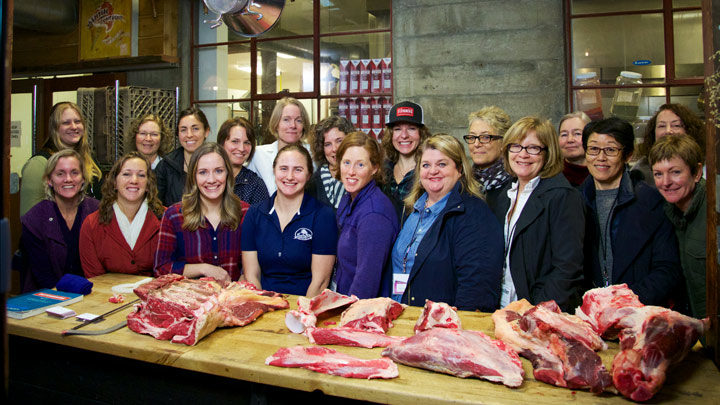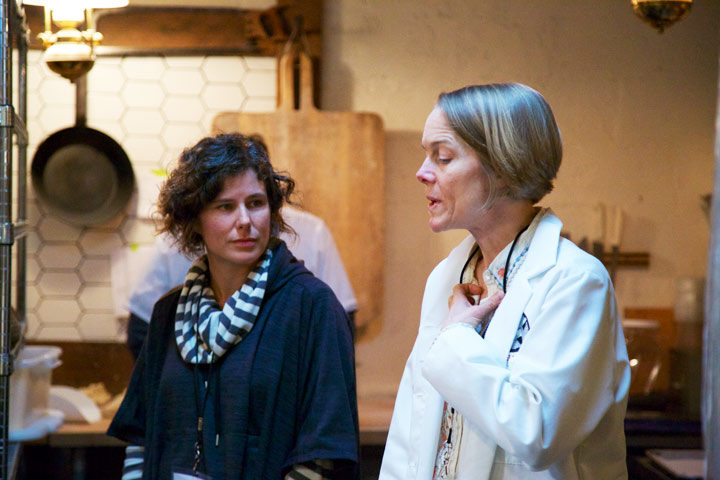This video of a 2-hour beef butchery workshop is intended for those interested in learning how to butcher a cow and discusses some of the special challenges of establishing local niche meat processing for producers and buyers. Samantha Garwin of Fleishers Craft Butchery, demonstrates the beef breakdown process of a forequarter bovine carcass. Included in the demonstration are questions from an audience with diverse backgrounds in the food industry. Also in the video, Lauren Gwin, co-founder of the National Niche Meat Processor Assistance Network (NMPAN); Patty Kloft of Century Oak Packing; and Ben Meyers of Old Salt Market.

This workshop was part of the 5th National Conference for Women In Sustainable Agriculture.
According to NMPAN, a national assistance network to help promote and support the local meat processing industry, they define ‘niche meat’ in broad terms for different segments of the market, as follows:
- Locally raised
- certified organic
- grass-fed
- no hormones or antibiotics
- certified humane
In general terms, meat processing includes the following basic steps (Source: NMPAN):
- Slaughter of the live animal
- Cutting the chilled carcass to required size for restaurants, retail groceries, and other types of markets.) (see the above video as an example of the process)
- Value added processing which includes grinding (example, hamburger meat), making sausages, ham and bacon, and other types of meat products.

You may well ask the question: what’s the big deal about local meat processing? After all, isn’t there a plentiful supply of meat at the grocery, why the emphasis (or need) for a local supply?
When I posed this question to Rebecca Thistlewaite, program manager for the Niche Meat Processor Assistance Network, she responded, in part: “Local farmers and ranchers keep land in agriculture and our rural communities economically viable. Their dollars circulate throughout our regional economies many more times than a distant meat packer. Local meat also means we have local slaughterhouses, butchers, distributors, and cold storage- all essential parts of a thriving local food economy.”
In the Portland area, we are fortunate that there are choices for purchasing locally produced (or regional) meats as opposed to the average grocery chain whose selections often come from a distant meat packing facility sourced from conventionally raised livestock. Thistlewaite advises that people interested in purchasing locally produced meats, seek out their farmers market or community supported agriculture farm (CSA), or buy in larger amounts direct from the farm. Also, there may be farmer/rancher co-ops in your area (Country Natural Beef, is one of our local examples) that purchase from member farms and that may have desirable sustainability and animal welfare standards that offer a good value mix to consumers (eaters).
In order to maintain a local supply of niche meat to serve a particular market, there has to be a supply chain, and that supply chain must include local meat processors. A niche meat supply chain involves a number of complex and sometimes overlapping entities which require their own economies of scale (for production) in order to be economically viable over time. It’s very tough (and costly) to open a slaughter facility (often an important impediment to establishing a local meat supply chain) or a niche meat processing plant where a steady supply of livestock must be maintained throughout the year. The whole ecosystem depends upon enough steady consumer demand for all the products produced from an animal, not only the most prized parts.
This is why local communities find it so difficult to create their own niche meat processing ecosystem that can flourish.

This video was sponsored by Oregon State University, Niche Meat Processor Assistance Network.
Most of the videos featured on Cooking Up a Story were produced, filmed, and edited by Rebecca Gerendasy. Fred Gerendasy contributed as a writer to many of the posts and occasionally as the interviewer. Visit Rebecca Gerendasy Clay – Art and Fred Gerendasy Photography to see their current work.
